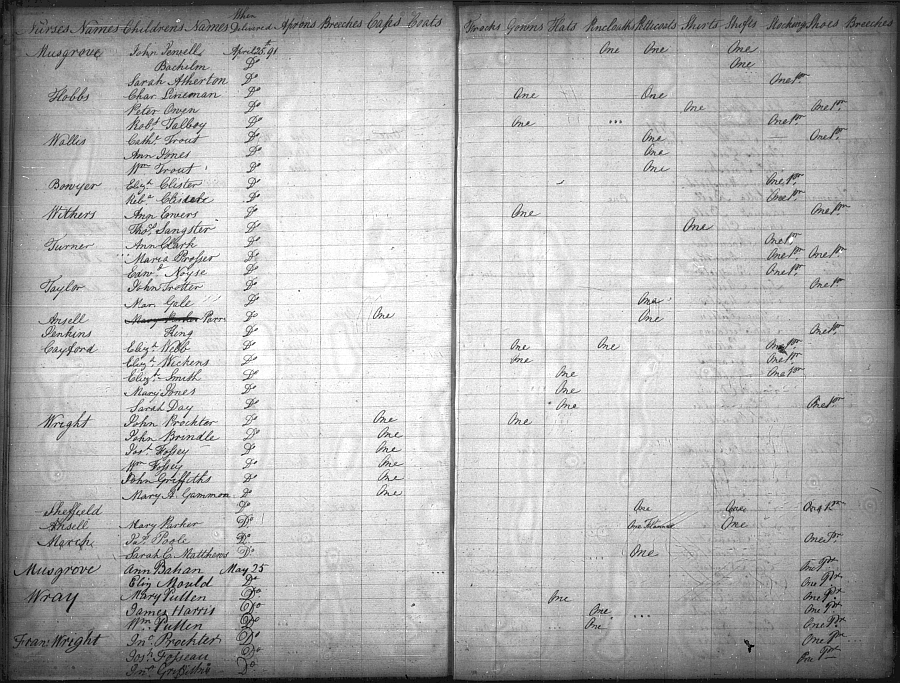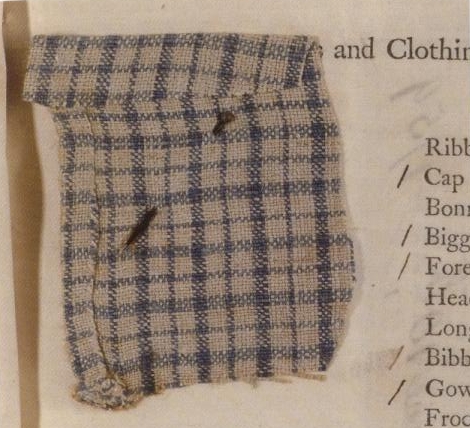Parish Clothing Books, with Names of Children at Nurse (BN)
 St Clement Danes, Clothing Books, and Children Put to Nurse, 1790-1800, Westminster Archives Centre, Ms B1263, LL ref: WCCDBN356000024&5.
St Clement Danes, Clothing Books, and Children Put to Nurse, 1790-1800, Westminster Archives Centre, Ms B1263, LL ref: WCCDBN356000024&5.
Introduction
From 1784 the parish of St Clement Danes substantially reformed its care of abandoned and orphaned children, and these Clothing Books, as well as the associated Enfield Books (BE), are a product of that reform.
Jonas Hanway and the Reform of St Clement Danes
As explained under Enfield Books (BE), St Clement Danes was held up to public censure by Jonas Hanway in the 1760s for its alleged poor standards of care for the infant poor. Hanway's campaigning led to the passage of legislation which required parishes to keep a register of the infant poor, and stipulated that all parish infants from greater London be nursed in a rural environment at least three miles from the capital.1 Although it took half a generation for these reforms to take hold, from the mid-1780s the parish both created a series of ongoing relationships with a group of nurses located in the Enfield area, north of London, and started to keep a series of more precise and full records. These Clothing Books, and the associated Enfield Books were a result from these reforms.
 A scrap of check linen left with a Foundling child. London Metropolitan Archives, A/FH/A9/1/147. Foundling no.13169. 1759. © John Styles and The Foundling Hospital Museum.
A scrap of check linen left with a Foundling child. London Metropolitan Archives, A/FH/A9/1/147. Foundling no.13169. 1759. © John Styles and The Foundling Hospital Museum.
The distinctive element of these books, and the reason they are catalogued separately from the more generic form of Clothing Books (BC), is that they are organised according to the name of the nurse in whose care an individual pauper child was placed, and demonstrate the large-scale businesses run by the Enfield nurses who were employed by St Clement Danes.2
Layout and Content
These Clothing Books are organised as tables across two pages of a bound volume, with the Nurse's Names in the left hand column, followed the name of the children in that nurse's charge, and the date on which specific items of clothing were issued. Clothing was issued approximately once a month to the children, and the volume is ordered chronologically according to these monthly dates, which appear in column three. This is followed by a series of columns headed with different types of clothing. Most pages include columns for: Aprons, Breeches, Caps, Coats, Frocks, Gowns, Pin Cloaths, Petticoats, Shirts, Shifts, Stockings, Shoes, Breeches. When the item is distributed the word one is entered in the row next to the child's name.3
Because this table format does not reproduce well in transcription, it is best to look at the original page images.
Introductory Reading
- Hitchcock, Tim. Down and Out in Eighteenth-Century London. 2004, ch.5 & 6.
- Jones, Peter. Clothing the Poor in Early Nineteenth-Century England. Textile History, 37:1 (2006), pp. 17-37.
- Styles, John. The Dress of the People: Everyday Fashion in Eighteenth-Century England. New Haven, 2008.
- Taylor, James Stephen. Jonas Hanway, Founder of the Marine Society: Charity and Policy in Eighteenth-Century Britain. 1985.
Online Resources
For further reading on this subject see the London Lives Bibliography.
Documents Included on this Website
- St Clement Danes, Clothing Books, and Children Put to Nurse, 1790-1800, Westminster Archives Centre, Ms. B1263, LL ref: WCCDBN35600, Tagging Level: B
- St Clement Danes, Clothing Books, and Children Put to Nurse, 1799-1800, Westminster Archives Centre, Ms. B1264, LL ref: WCCDBN35601, Tagging Level: C
Back to Top | Introductory Reading
Footnotes
1 7 George III c. 39. ⇑
2 For a detailed discussion of the fates of parish children left in the care of London parishes, see Katrina Honeyman, Child Workers in England, 1780-1820 (Aldershot, 2007). ⇑
3 For an authoritative discussion of the parish poor as "involuntary consumers" of clothing, see John Styles, The Dress of the People: Everyday Fashion in Eighteenth-Century England (London and New Haven, 2008), ch. 16. ⇑